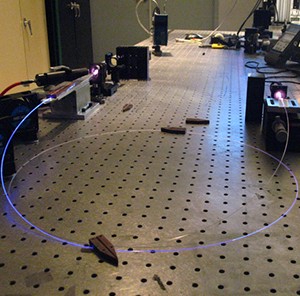Expanding Fiber Lasers from Near-IR to Mid-IR is Enabling New Applications for Military and Medical
March 3, 2016
On Thursday, March 10, and Friday, March 11, CREOL, The College of Optics & Photonics will host The 2016 Industrial Affiliates Symposium: Advances in Optics and Photonics. Activities will include short courses, industrial affiliates’ exhibits, technical exhibits, a poster session, lab tours, a reception, technical talks by CREOL faculty, and presentations given by invited distinguished speakers.
One of the short courses on Thursday will be taught by Lawrence (Larry) Shah, Ph.D., research assistant professor at CREOL and profiled in our Faculty Feature this month. His lecture will focus on one of his research topics, fiber lasers. This industry has experienced marked growth, with promise for continued expansion. Research and Markets reports that the global fiber laser market will grow with a CAGR of 16.2 percent between the years of 2014 and 2019.
Fiber lasers are used within a variety of applications including medical, materials processing, marking and engraving, long-haul telecommunications, and directed energy weapons systems. The development of new fiber laser technology requires multidisciplinary basic research initiatives, such as the ones that occur in Shah’s lab.
How Fiber Lasers Work
To create a fiber laser beam, a pump source, usually a diode pump laser, pushes power through a laser cavity. In one scenario, the fiber laser could use refracted glass with striped etchings called Bragg gratings. These reflectors are located on either end of an optical fiber (the laser medium), so that more photons can be generated as the light is refracted and then reflected back and forth. In order for this light to be useful, it needs to be released. The laser beam is emitted through the second Bragg grating, which allows only a small amount of the light out.
Optical fibers are formed from silica glass and usually doped, or treated, with elements such as neodymium, holmium, erbium, thulium, and ytterbium. Ions of these materials are found at the bottom of the periodic table in a group called rare-earth elements or lanthanides. Depending on the dopant ions, these fibers can efficiently carry wavelengths at near-infrared levels, from 790-980nm, which is a subset of the entire near-infrared spectrum. For example, ytterbium-doped fiber lasers operate at 1-micron (1000nm) wavelength and are commonly used in commercial applications. However, Shah is leading basic research efforts to develop fiber lasers that can operate at 2-micron (2000nm) wavelength. The fibers that allow for this increase are a relatively new and cutting-edge innovation.
In addition to the dopants used, the types of fibers also vary based on how they affect the laser beam quality. Gain, or active, fibers, which are used in military applications, primarily alter the light’s brightness, but can also change the light’s wavelength. Passive fibers, most commonly used in telecommunications applications, are optimized to transport light with minimal loss. Optical fibers also come in a variety of lengths, with active fibers generally between 10 cm – 10 m in length, while sections of passive fibers for telecommunications can commonly measure many kilometers.
Fiber Laser Research Questions and Challenges
In terms of output power, active optical fiber performance ultimately depends on the distribution of optical intensity throughout the system. For average power scaling, where a continuous wave (CW) of power is pumped through the optical fiber, performance is fundamentally limited by the heat generated in the gain medium relative to the rate of heat removal and the impact of induced thermal gradients (the rate of temperature change over a distance).
In addition to this heat challenge, Shah’s research also focuses on scaling peak power (which occurs in a short pulse usually between 1-100 nanoseconds) to reach as high as multiple megawatts in the fiber. At such peak powers, the laser fluence and intensity can vaporize most materials (beneficial for weapon systems). At this level of power, it is important to avoid optical damage within the laser system itself.
—
Shah believes that his most important mission is to educate students to translate basic research into applied research. In laser development, this includes proper thermal management of a laser system, maximizing the stability of the testing environment, and accurately detailing a system’s performance. As demand for fiber lasers continues to increase, there is a growing need for those who have experience managing the unique capabilities and challenges associated with optimizing performance aspects of fiber lasers (e.g., power, beam quality, and stability within these systems). Furthermore, the expansion of fiber lasers from the near-infrared towards mid-infrared wavelengths is enabling new applications, particularly in medical and remote sensing, for utilization outside of the laboratory environment.
—
To learn more about Shah’s work in fiber lasers and about potential licensing opportunities, contact John Miner for more information.
